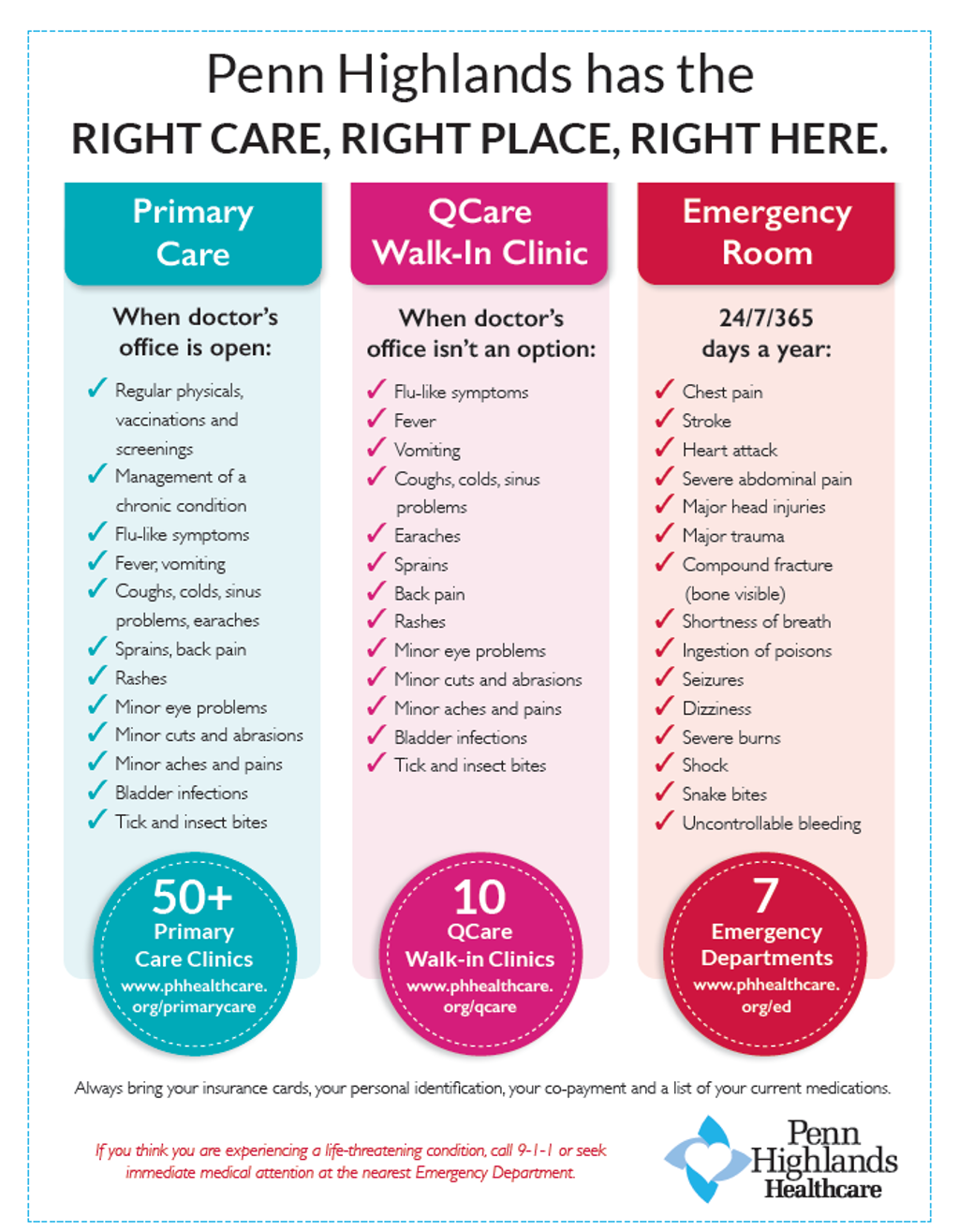When to Go to the Emergency Room, PCP or a Walk-in Clinic
You have discomfort in your chest and are lightheaded — should you go to the Emergency Department? You have a rash on your arms — should you go to the Emergency Department? You have fever, cough and new loss of taste or smell — should you go to the Emergency Department? According to Dr. Shaun M. Sheehan, DO, Corporate Emergency Services and Transfer Center Medical Director at Penn Highlands Healthcare, the answers are yes, no and no.
“If the symptoms are sudden onset or it is a life-threatening illness or injury, you should go straight to the Emergency Department; and, if the symptoms warrant, call 911 to get you there faster,” explained Dr. Sheehan. “Primary care physicians and walk-in centers are great for non-life threatening illnesses and injuries such as rashes, sprains and cold symptoms.”
With the recent surge in COVID-19 cases resulting in record high ICU admissions throughout Pennsylvania, people who visit any hospital Emergency Department for non-life-threatening conditions — from the eastern portion of the commonwealth to the western part — may have to wait longer before they are seen than they may have experienced prior to the pandemic.
In hospital Emergency Departments (ED), a triage system is followed to prioritize the most severely ill or injured patients. Even people who arrive at the ED by ambulance, who do not present with life-threatening conditions or injuries, may have to wait long periods to be evaluated and treated. From animal bites and earaches to sprains and minor burns, PCPs and walk-in clinics typically can see you, treat you and send you home faster than at a hospital ED.
“While everyone considers their own medical needs an emergency, pinkeye is not afforded the same level of urgency as stoke symptoms in a hospital ED,” Dr. Sheehan said.
Many physician practices now offer tele visits enabling people to meet with their primary care providers from the comfort of their own homes using a smart phone.
Dr. Sheehan points out that illnesses and injuries do not always happen when primary care providers are in their offices — that’s why walk-in clinics are popular. In many instances, the clinics are open evenings and weekends. The clinics also are a great alternative to EDs for people who do not have a family doctor and need medical care.
In addition, walk-in clinics may be more economical than an Emergency Department visit. For example, the Penn Highlands QCare Walk-in Clinics are considered an extension of primary care offices; they are billed as a physician office visit which in many instances the copay is lower than for an Emergency Department visit copay.
Dr. Sheehan also cautions people that EDs and walk-in clinics are not the places to go for COVID-19 testing. People who suspect their symptoms may be COVID-19 or those who may have had an exposure and require a COVID-19 test are advised to first contact their primary care physicians. In addition, many pharmacies still offer COVID-19 tests.
“When people do not feel well or are in pain, the last thing they want to do is wait a long time for treatment; that’s why we recommend contacting your PCP or visiting walk-in centers for non-life-threatening illnesses and injuries,” said Dr. Sheehan.
PCPs can be physicians, nurse practitioners or physician assistants. PCPs help you avoid emergencies, and you are more likely to have better health if you visit your PCP regularly. The Penn Highlands Healthcare, primary care providers include internal medicine, family medicine and pediatric practices to cover all ages of life.
In addition, Penn Highlands Healthcare offers QCare Walk-in Clinics in Brookville, Clarion, Clearfield, DuBois, Emporium, Huntingdon, Philipsburg, Punxsutawney, Ridgway and St. Marys. For locations and hours, visit phhealthcare.org/qcare.


